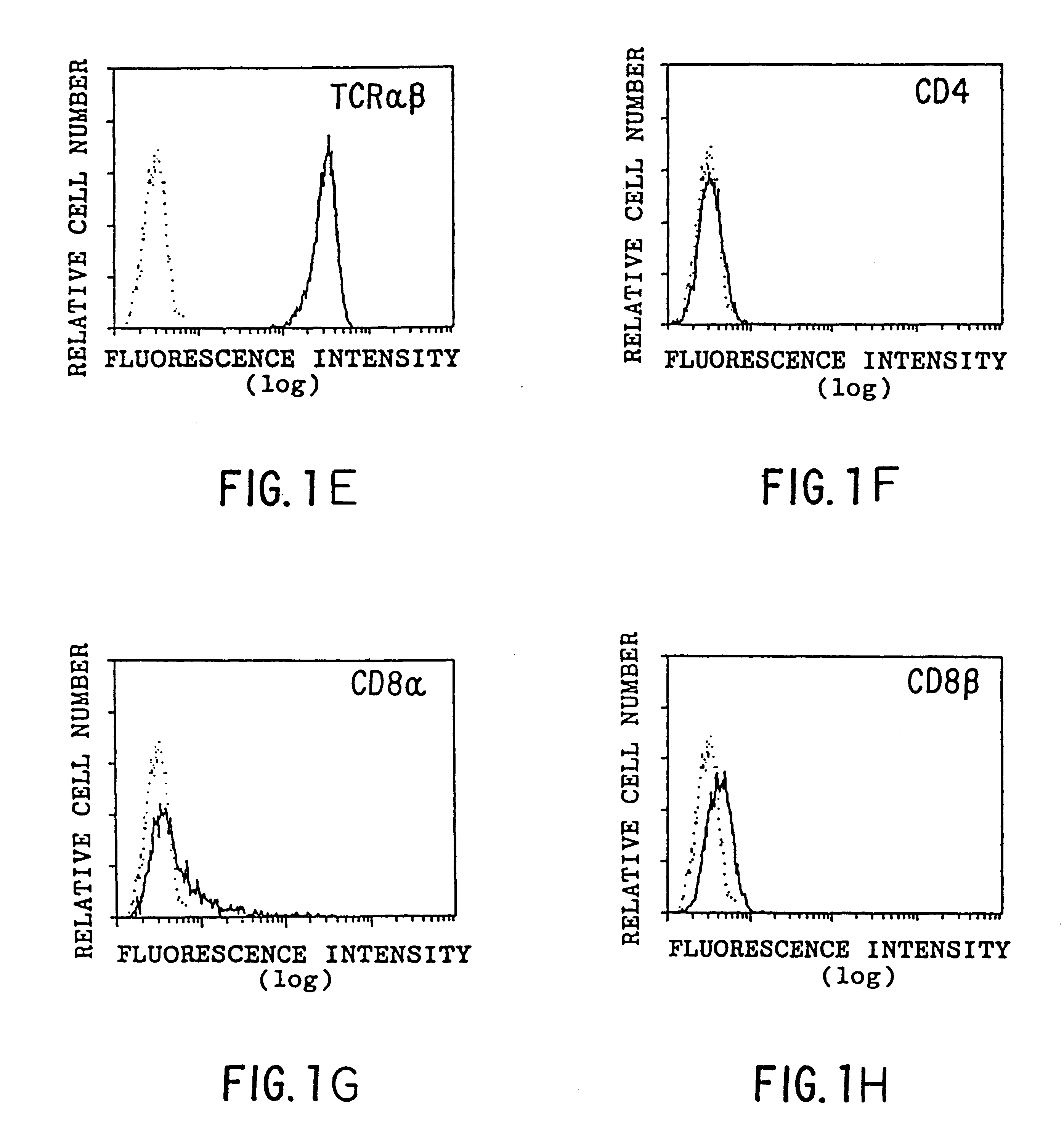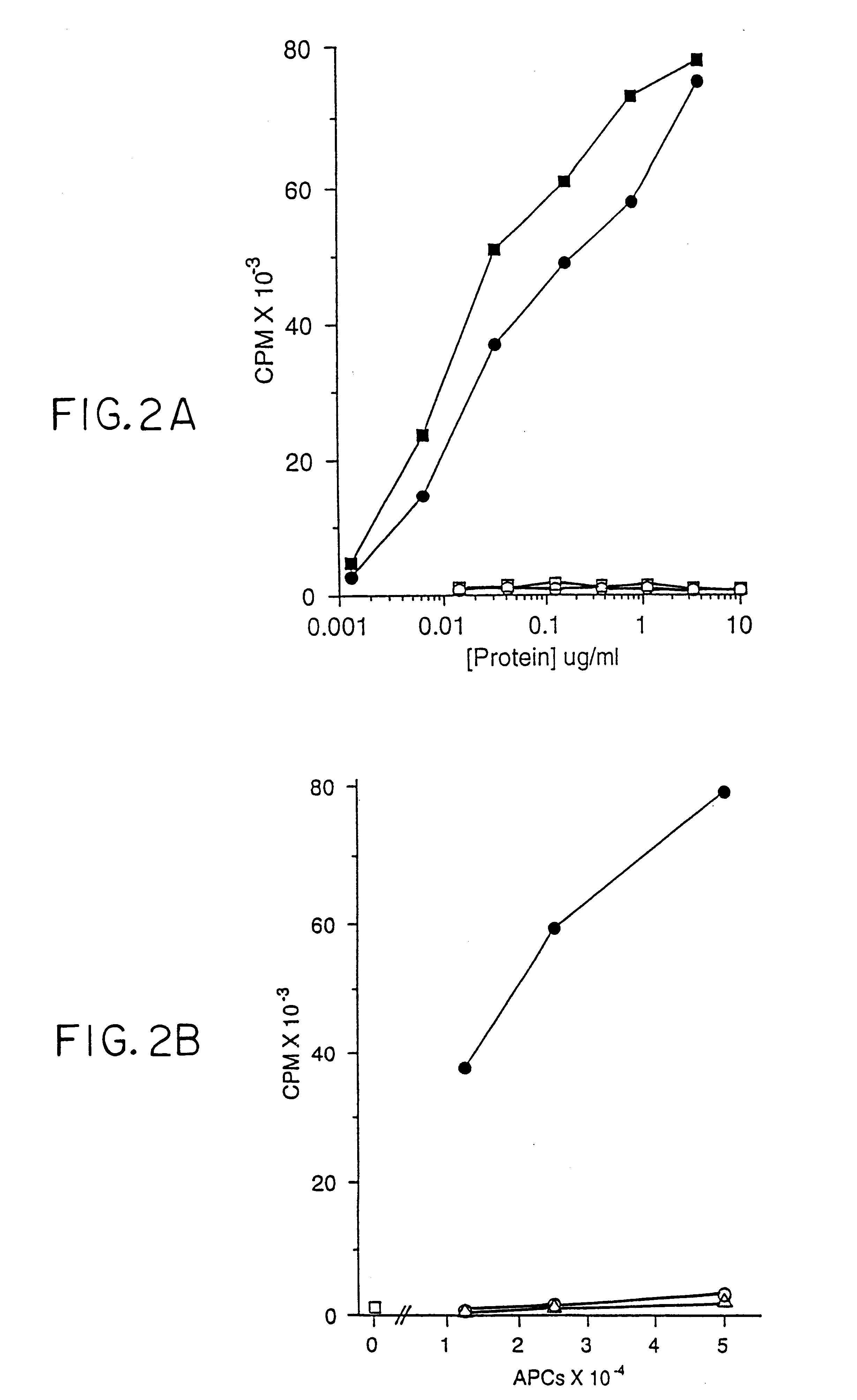Presentation of hydrophobic antigens to T-cells by CD1 molecules
a technology of hydrophobic antigens and t-cells, applied in the field of presenting hydrophobic antigens to t-cells by cd1 molecules, can solve the problems of increasing at a nearly logarithmic rate, insufficient recognition of peptide antigen alone or mhc gene product alone to signal t-cell activation, and insufficient current mycobacterial vaccines
- Summary
- Abstract
- Description
- Claims
- Application Information
AI Technical Summary
Problems solved by technology
Method used
Image
Examples
example 1
Antigen Presentation by CD1b
Methods
Flow cytometry was performed as described previously (Panchamoorthy, G., et al., J. Immunology 147:3360-3369 (1991)) using the following monoclonal antibodies (mAbs): P3 (IgG1 control; Panchamoorthy, G., et al., J. Immunology 147:3360-3369 (1991)), OKT6 (anti-CD1a; Reinherz, E., et al., Proc. Natl. Acad. Sci. (USA) 77:1588-1592 (1980)), 4A7.6 (anti-CD1b; Olive, D., et al., Immunogenetics 20:253-264 (1984)), 10C3 (anti-CD1c; Martin, L. H., et al., Proc. Natl. Acad. Sci. (USA) 84:9189-9193 (1987)), W6 / 32 (anti-HLA-A,B,C; Brodsky, F. M., and Parham, P. P., J. Immunology 128:129-135 (1982)), BMA031 (anti-.alpha.:.beta. TCR; Lanier, L. L., et al., in Leukocyte Typing III, McMichael, A. J., ed., pp. 175-178, Oxford University Press, 1987), OKT4 (anti-CD4; Reinherz, E., et al., Proc. Natl. Acad. Sci. (USA) 77:1588-1592 (1980)), OKT8 (anti-CD8.alpha.; Reinherz, E., et al., Proc. Natl. Acad. Sci. (USA) 77:1588-1592 (1980)) and 2ST8-5H7 (anti-CD8.beta.; Shiu...
example 2
A Non-Peptide Antigen is Presented by CD1b
Methods
The CD1b-presented antigen is a nondialyzable macromolecule (data not shown). More antigenic (i.e., T-cell proliferative) activity could be obtained from soluble aqueous sonicates of M. tb. by adding detergents such as CHAPS or octylglucoside during the sonication (see above). This result suggests that the antigen is hydrophobic.
In order to characterize the chemical nature of the antigens presented by CD1, mycobacterial antigens were purified from the nonpathogenic M. tb. strain H37Ra (Difco) and M. fortuitum (a rapidly growing strain that also contains antigenic activity). Bacteria were either commercially available (M. tb. H37Ra, Difco) or grown and harvested (M. fortuitum), sonicated and subjected to sequential fractionation protocols and analyzed for biological activity. All fractions generated were tested for their ability to stimulate the DN T-cell line DN1 in a 5 day proliferation assay using irradiated, GM-CSF- and IL-4treated...
example 3
Purification of a CD1b-Presented Antigen from M. tuberculosis
Methods
M. fortuitum bacteria were grown in liquid culture to stationary phase and collected by centrifugation, sterilized by stream autoclaving (250.degree. C., 18 p.s.i.) and lyophilized. Desiccated M. tb. (strain H37Ra, Difco) or M. fortuitum bacteria were suspended in phosphate buffered saline (200 mg bacteria per 5 ml PBS), and the bacterial suspension was sonicated with a probe sonicator to disrupt the cells. The resulting sonicate was extracted with organic solvents using a Folch based 2 phase extraction system (chloroform / methanol / water) which quantitatively extracts mycobacterial lipids into an organic phase. Goren, M. B., and Brennan, P. J., Mycobacterial Lipids: Chemistry and Biologic Activities in Tuberculosis, 1979. The sonicate was combined with three volumes of a chloroform:methanol (2:1 v / v) solution in a glass container, and the mixture was vigorously shaken at room temperature for 24 hours. The phases of t...
PUM
| Property | Measurement | Unit |
|---|---|---|
| molecular weights | aaaaa | aaaaa |
| molecular weights | aaaaa | aaaaa |
| molecular weights | aaaaa | aaaaa |
Abstract
Description
Claims
Application Information
 Login to View More
Login to View More - R&D
- Intellectual Property
- Life Sciences
- Materials
- Tech Scout
- Unparalleled Data Quality
- Higher Quality Content
- 60% Fewer Hallucinations
Browse by: Latest US Patents, China's latest patents, Technical Efficacy Thesaurus, Application Domain, Technology Topic, Popular Technical Reports.
© 2025 PatSnap. All rights reserved.Legal|Privacy policy|Modern Slavery Act Transparency Statement|Sitemap|About US| Contact US: help@patsnap.com



